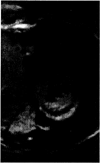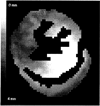DENSE: displacement encoding with stimulated echoes in cardiac functional MRI
- PMID: 10053155
- PMCID: PMC2887318
- DOI: 10.1006/jmre.1998.1676
DENSE: displacement encoding with stimulated echoes in cardiac functional MRI
Abstract
Displacement encoding with stimulated echoes (DENSE) was developed for high-resolution myocardial displacement mapping. Pixel phase is modulated by myocardial displacement and data spatial resolution is limited only by pixel size. 2D displacement vector maps were generated for the systolic action in canines with 0.94 x 1.9 mm nominal in-plane resolution and 2.3 mm/pi displacement encoding. A radial strain of 0.208 was measured across the free left ventricular wall over 105 ms during systole. DENSE displacement maps require small first-order gradient moments for encoding. DENSE magnitude images exhibit black-blood contrast which allows for better myocardial definition and reduced motion-related artifacts.
Figures







References
-
- Reichek N. Magn. Reson. Q. 1991;7:255–274. - PubMed
-
- Young AA, Kramer CM, Ferrari VA, Axel L, Reichek N. Circulation. 1994;90:854–867. - PubMed
-
- Young AA, Fayad ZA, Axel L. Am. J. Physiol. 1996;271:H2677–H2688. - PubMed
-
- Kramer CM, Rogers WJ, Theobald TM, Power TP, Petruolo S, Reichek N. Circulation. 1996;94:660–666. - PubMed
-
- Pattynama PM, de Roos A, van der Wall EE, Van Voorthuisen AE. Am. Heart J. 1994;128:595–607. - PubMed
Publication types
MeSH terms
Grants and funding
LinkOut - more resources
Full Text Sources
Other Literature Sources
Medical
Research Materials
Miscellaneous

